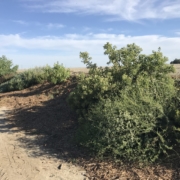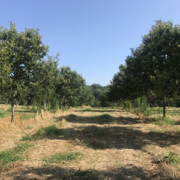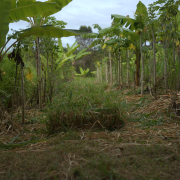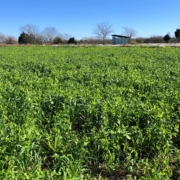Conservation Hedgerows for the Southwest
 Print This Post
Print This Post
By Katherine Favor, NCAT Sustainable Agriculture Specialist
“Kill two birds with one stone” — isn’t it time this old adage got an update? Instead of killing two birds with one stone, why don’t we save two birds with one hedgerow? And protect soil from erosion while we’re at it? And protect plants from wind damage, too? And do a bunch of other great things that benefit humans, animals, and the environment? When it comes to achieving multiple goals at once, conservation hedgerows are a shining example.
Conservation hedgerows are an agroforestry practice defined by NRCS as “dense woody vegetation planted in a linear design to achieve a natural resource conservation purpose” (NRCS, 2021). Hedgerows are one of those agroforestry practices that don’t fit neatly into any one of the five recognized temperate agroforestry practices, but rather, that fall under that ambiguous category of “additional applications.” NRCS often uses the term conservation hedgerows, the USDA National Agroforestry Center often uses the term windbreaks, and both agencies often use the term conservation buffers to describe variations of this practice. While all these terms do have nuanced differences, the practices have the same general characterization: they are all linear rows of woody perennials planted to achieve a conservation purpose. At the end of the day, no matter what you want to call them, trees planted in a linear fashion around the edges of your farm can serve many functions (Bentrup, 2008; Smukler et al., 2010; Wilcox and Murphy, 1985):
- Hedgerows improve air quality by sequestering carbon dioxide, slowing pesticide drift, and filtering pollutants from the air.
- Hedgerows improve water quality by slowing runoff, increasing infiltration rates, and stabilizing slopes, and by trapping pollutants, nutrients, and sediment in both surface runoff and subsurface flow.
- Hedgerows improve the soil by breaking up compaction, stabilizing slopes, and preventing wind and water erosion.
- Hedgerows increase biodiversity by providing habitat for pollinators, beneficial insects, birds, bats, and other animals, and by connecting patches of habitat to support wildlife migration.
- Hedgerows improve human health and wellbeing by enhancing visual aesthetics, buffering noise, controlling odors, and preventing pesticide drift.
If you’re thinking about planting a hedgerow, the first thing you’ll want to do is think about your goals, so that you can select a species mix and a design layout that is right for you. Is your main goal to provide habitat to pollinators so you don’t have to import bees? If so, you’ll want to choose a wide variety of hedgerow plants that flower at all different times of the year. Is your goal to create a windbreak and reduce erosion? If so, you’ll want to add some tall trees to your mix, and you’ll want to plant your hedgerows in staggered rows with a close spacing, so that your final foliage density is around 50-65%. Evaluating your goals and deciding what you want to get out of your hedgerow is always step one.
Once you evaluate your goals, it’s time to choose your species. There are many species that can be used for hedgerow plantings in the West and Southwest. It’s important to contact your local NRCS field office for specific recommendations, but examples of hedgerow plants for arid southwestern regions include elderberry (Sambucus spp.), redbud (Cercis Canadensis), New Mexican privet (Forestiera spp.), Rocky Mountain juniper (Juniperus scopulorum), American plum (Prunus americana), dogwood (Cornus spp.), willow (Salix spp.), yaupon holly (Ilex vomitoria), cottonwood (Populus spp.), serviceberry (Amelanchier spp.), toyon (Heteromeles arbutifolia), and velvet mesquite (Prosopis velutina), to name a few. The species you choose will depend on a variety of factors, but good rules of thumb are as follows:
- Select species that are native, noninvasive, and nontoxic.
- Select species that bloom year-round. Include at least three early-flowering varieties, three mid-flowering varieties, and three late-flowering varieties in your mix.
- Try to include a mix of evergreens and deciduous trees to maintain continuous vegetation throughout the year.
- Choose perennial plants that are at least 3 feet tall.
Once you’ve got your species selected, the next step is to decide how you want to lay out your hedgerow. Consider the following:
- Plant hedgerows on the perimeter of your property, or in linear rows within your field.
- If a goal of your hedgerow planting is to act as a windbreak, orient your hedgerow so that it is perpendicular to the prevailing wind as much as possible.
- If a goal of your hedgerow is to act as a windbreak or to buffer particulate matter, space plants so that the final foliage density is 50-65%.
- A 15-foot minimum width is recommended. To achieve this, it is recommended to plant at least two staggered rows.
- Follow spacing guidelines for the plants that you have chosen in your species selection.
Now it’s time to get them in the ground! When you’re planting your hedgerows, make sure to:
- Weed the entire area before you plant. Weeds can make or break the success of your hedgerow, so this step is very important!
- Lay down drip irrigation so that your plants will receive water when they’re being established. Plan on irrigating once or twice a week for the first few years.
- Apply mulch to suppress weeds and maintain soil moisture. Wood chip mulch is a good choice, but other mulches, including plastic mulch, can work too.
Once your hedgerows are established, it’s important to continue giving them good care. As with all agroforestry systems, hedgerows are intensive, and maintaining them with an intentional and consistent management plan is key. Make sure you:
- Continue to irrigate until the hedgerows are several years old. Once they are well-established, wean them off water slowly. In very arid areas, you might need to keep irrigating them indefinitely.
- Keep the area weed-free.
- Refrain from applying pesticides to your hedgerows and prevent pesticide drift from arriving to your hedgerows as much as possible. You don’t want to harm the pollinators and beneficial insects that you are attracting!
- Replace dead plants so that your hedgerow remains continuous. You want to make sure that there are no gaps in vegetation, especially if one of your goals for your hedgerow is to function as a windbreak.
If you follow these rules of thumb, you’ll be well on your way to saving many birds with one hedgerow, along with achieving lots of other conservation goals at the same time. For more information about how to start a hedgerow planting, contact NCAT’s Western office at 530-792-7338.
Related ATTRA Resources:
A Pictorial Guide to Hedgerow Plants for Beneficial Insects
Miles of Hedgerows, a California Project Update
Other Resources:
Trees for Conservation: a buyer’s guide, USDA National Agroforestry Center
Working Trees Info: Can Windbreaks do More than Slow the Wind?, USDA National Agroforestry Center
Monarch Nectar Plants Southwest, Xerces Society for Invertebrate Conservation
This blog is produced by the National Center for Appropriate Technology through the ATTRA Sustainable Agriculture program, under a cooperative agreement with USDA Rural Development. ATTRA.NCAT.ORG.











